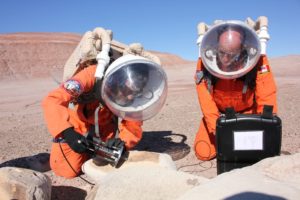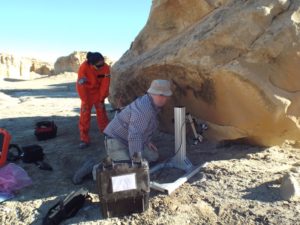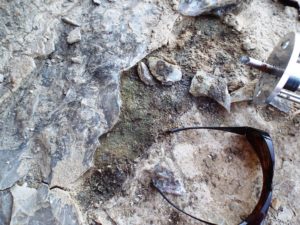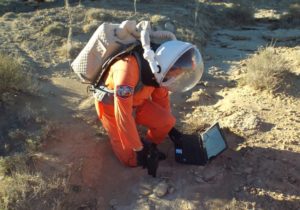Technology Narrative – November 12th
ASTRONAUT TOOLS
Jon Clarke
Astronauts have used a wide range of tools over the years to perform their tasks. Some, some as the geological hammers used by the Apollo astronauts on the Moon, were almost identical to what would be used on Earth. Other tools, like the “flyswatter” used to deal with an errant satellite by the crew of STS-51D, are more specialised.
The Apollo astronauts on the Moon also used many other tools – tongs, scoops, and rakes to pick up different types of surface sample; various cameras; small shovels; rotary drills; scribers; push corers, and a curious device called gnomon to orient photographs. Future astronauts on Mars will probably use similar tools, as well as new instruments that have been developed in the interim – multispectral cameras, continuous individual video, hand held spectrometers, XRF and XRF analysers, as well as tools designed to deal with the need for contamination-free samples for astrobiology research.
Dr Mike-Curtis-Rouse of the UK Space Agency (right) and myself testing SPLIT near MDRS
Earlier in I had the privilege to test one such tool, the SPLIT, a small percussive tool developed by the UK Space Agency to expose contamination-free fresh rock surface by robots or astronauts. With Dr Mike Curtis-Rouse of UKSA I trialled this tool on a number of different rocks in the vicinity of MDRS.
SPLIT being set up in platform mode near Factory Butte by John Holt of Leicester University, Anushree looks on.
The next day we tested the SPLIT in platform mode, as if it were on a robotic rover near Factory Butte. SPLIT pecked away at fractured rock surfaces until they fell away, exposing fresh rock that could be scanned by rover instruments. The chosen tests sites were all accessible by a robotic rover. They were overhanging and north-facing rocks with one or more metres of overlying material. Such locations on Mars would offer substantial radiation protection for organics or extent life. SPLIT successfully exposed organics beneath a gypsum vein on one of the trials.
Green microorganisms living beneath gypsum vein exposed by SPLIT
Mark Edward, also of the UK Space Agency donned a MDRS suit and scanned a range of in the Factory Butte area with a portable laser Raman spectrometer to determine mineralogy and organic content. Improved versions of this tool is likely to be among the suite available to astronauts on Mars because of its simplicity, capability, and portability. Incidentally, November 7th was the anniversary of the birth of C. V. Raman, the Indian physicist who discovered the Mossbauer Effect for which he was awarded the Nobel Prize in 1930. I wonder what he would have thought of instruments based on his discovery one day flying to Mars?
Mark Edwards of the UK space Agency successfully testing a field portable laser Raman spectrometer while wearing a MDRS suit.
Evaluation proceeds both ways. So the UK Space Agency people who wore our suits gave us useful feedback about temperature, ventilation, and the need for water supply to the wearers of the MDRS suits. No doubt these suggestions will be included in future versions.







